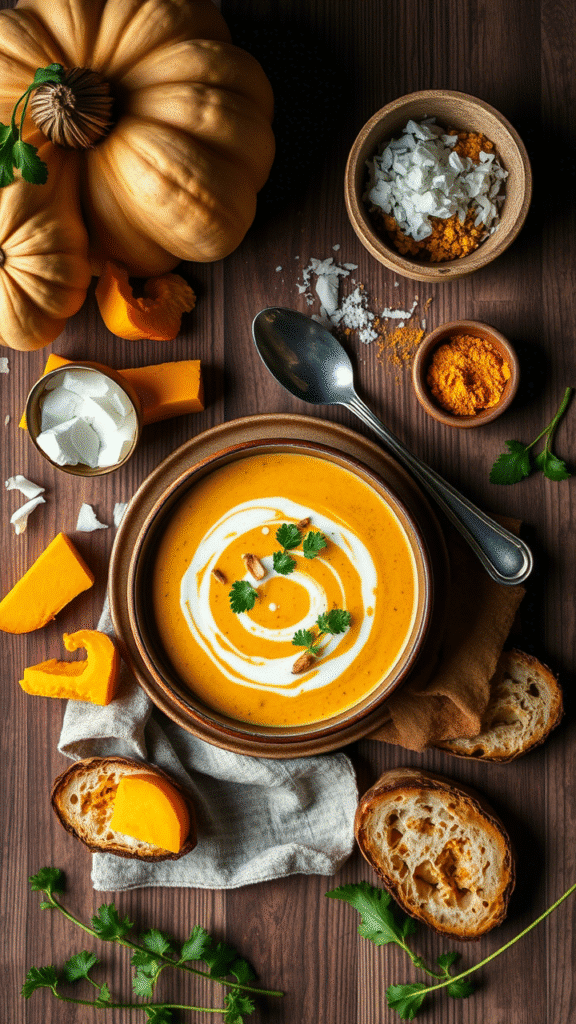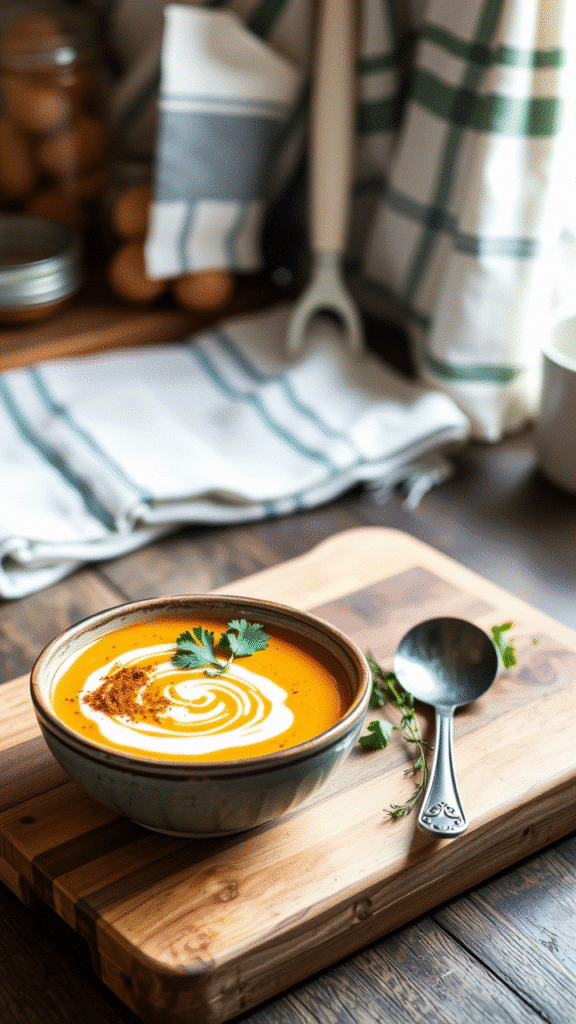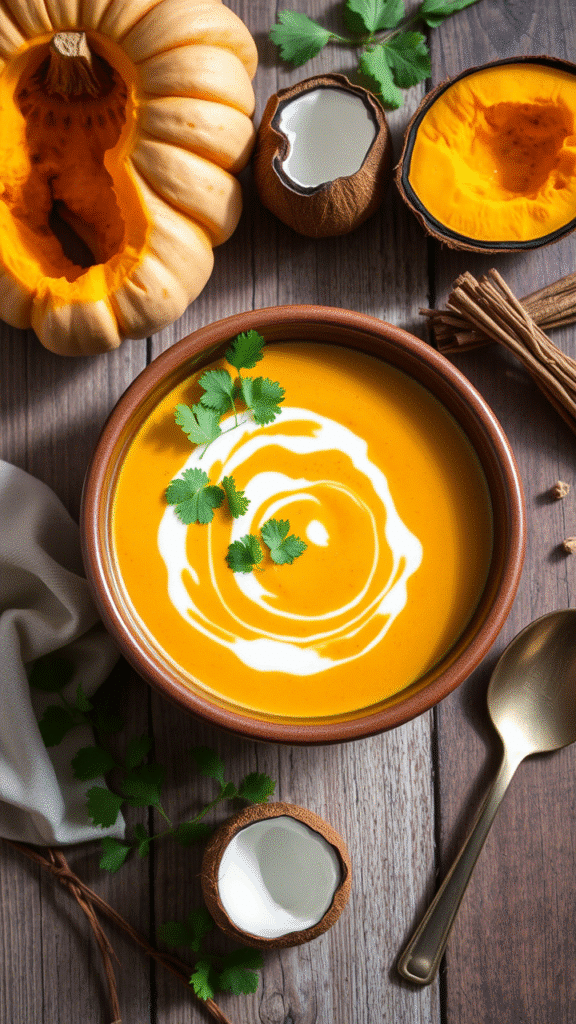I’ll never forget the first time I tasted properly made coconut curry pumpkin soup at a small restaurant in Bangkok’s Chinatown. The chef, a third-generation Thai cook, had somehow managed to balance the earthy sweetness of roasted pumpkin with the complex heat of red curry paste and the richness of coconut milk in a way that made every spoonful feel like discovering something entirely new. That bowl changed how I thought about seasonal cooking forever.
This isn’t your average fall comfort food. Creamy coconut curry pumpkin soup represents the beautiful marriage between Western seasonal ingredients and Southeast Asian flavor profiles, creating something that’s both familiar and exotic. The technique behind this soup goes far beyond simply throwing ingredients into a pot—it’s about understanding how to coax maximum flavor from each component while building layers of complexity that reveal themselves with every taste.
What makes this particular soup special is its ability to transform humble pumpkin into something transcendent. The roasting process caramelizes the pumpkin’s natural sugars, while the curry paste provides depth and heat that cuts through the coconut milk’s richness. It’s a masterclass in balance that professional chefs have been perfecting for decades.
The Foundation: Understanding Your Ingredients
Primary Components
Sugar Pumpkin (3-4 pounds) – Also called pie pumpkins, these varieties contain less water and more concentrated flavor than their jack-o’-lantern cousins. Look for specimens that feel heavy for their size with unblemished skin.
Full-fat coconut milk (2 cans, 14 oz each) – Never skimp on the quality here. Premium brands like Chaokoh or Aroy-D contain no stabilizers and separate naturally, giving you access to the thick cream that rises to the top.
Red curry paste (3-4 tablespoons) – Mae Ploy remains the gold standard among professional kitchens. Fresh paste from Asian markets will always outperform jarred alternatives, but quality commercial options work excellently.
Fresh ginger (2-inch piece) – Young ginger with thin, papery skin provides the brightest flavor. Older ginger works too but requires more aggressive peeling.
Lemongrass (2 stalks) – Use only the tender white and light green portions. The outer leaves are too fibrous but excellent for making stock.
Shallots (3 medium) – These provide sweetness without the harsh bite of regular onions. French gray shallots offer the most refined flavor profile.
Garlic (4 cloves) – Fresh garlic only—pre-minced loses its essential oils too quickly.
Vegetable or chicken stock (4-6 cups) – Homemade stock elevates this soup dramatically, but low-sodium commercial versions work in a pinch.
Flavor Enhancers
Fish sauce (2-3 tablespoons) – Red Boat or Three Crabs brands provide clean umami without overwhelming fishiness. Soy sauce works for vegetarian versions but lacks the same depth.
Palm sugar (2 tablespoons) – Brown sugar substitutes adequately, but palm sugar’s mineral complexity adds authenticity.
Lime juice (from 2-3 limes) – Always fresh, never bottled. The oils in the zest are equally important as the juice.
Thai basil – If unavailable, regular basil works, but Thai basil’s anise notes complement the curry paste beautifully.
Smart Substitutions for Dietary Needs
Professional kitchens often need to accommodate various dietary restrictions without compromising flavor. For dairy-free versions, this soup already fits perfectly. Vegan adaptations simply require omitting fish sauce in favor of additional soy sauce or mushroom sauce.
Those avoiding nightshades can substitute yellow curry paste for red, though the flavor profile shifts toward turmeric and galangal. Coconut aminos can replace soy sauce for those following strict paleo protocols.
For lower-fat versions, use light coconut milk but compensate by adding a tablespoon of coconut oil during the aromatics stage. This maintains richness while reducing overall calories.
Mastering the Technique: Step-by-Step Excellence

Phase One: Developing the Foundation
Begin by preheating your oven to 425°F. This high temperature is crucial for proper caramelization—lower temperatures simply steam the pumpkin rather than concentrating its flavors.
Cut your pumpkin in half and scoop out the seeds and stringy pulp. Reserve the seeds for roasting separately—they make an excellent garnish. Place the pumpkin halves cut-side down on a parchment-lined baking sheet. This positioning allows the cut surfaces to caramelize while the skin protects the flesh from burning.
Roast for 35-45 minutes until the flesh yields easily to gentle pressure. The skin should be lightly browned and slightly wrinkled. Overcooking leads to mushy texture, while undercooking leaves you with hard, flavorless chunks.
Phase Two: Building Aromatic Complexity
While the pumpkin roasts, prepare your aromatics. This is where many home cooks rush and lose crucial flavor development. Heat a heavy-bottomed pot over medium heat—cast iron or enameled Dutch ovens work best for even heat distribution.
Slice your shallots thinly and mince the garlic. Peel and julienne the ginger into thin strips. Remove the tough outer layers of the lemongrass and bruise the stalks with the flat side of your knife to release their oils.
Add a tablespoon of neutral oil to your pot. When it shimmers but doesn’t smoke, add the shallots. Cook them slowly, stirring occasionally, until they turn golden and fragrant—about 8-10 minutes. This patience pays dividends in the final soup’s depth.
Add the garlic and ginger, cooking for another 2 minutes until fragrant. The aromatics should sizzle gently, not aggressively. High heat at this stage creates bitter compounds that can’t be undone later.
Phase Three: Curry Paste Integration
This step seperates professionals from amateurs. Add your curry paste to the aromatics and cook it out for 3-4 minutes, stirring constantly. The paste should darken slightly and become incredibly fragrant. You’re essentially frying the paste, which blooms the spices and removes any raw taste.
Open your coconut milk cans and scoop out the thick cream that’s separated on top. Add this cream to the curry paste mixture and stir vigorously. The mixture will look broken and unappealing initially—this is normal. Continue cooking for 2-3 minutes until the oil begins to separate from the paste. This is called “cracking” the coconut cream, and it’s your visual cue that the flavors have properly melded.
Phase Four: Building the Soup Base
Add the remaining coconut milk and bring the mixture to a gentle simmer. By now, your pumpkin should be cool enough to handle. Scoop the flesh from the skins and add it directly to the pot along with the bruised lemongrass stalks.

Pour in 4 cups of stock initially—you can always add more later. Bring everything to a simmer and cook for 20-25 minutes, allowing the flavors to meld and the pumpkin to break down slightly.
Remove the lemongrass stalks and use an immersion blender to puree the soup until smooth. For the silkiest texture, strain the soup through a fine-mesh sieve, pressing the solids with a ladle to extract maximum flavor.
Phase Five: Final Seasoning and Balance
Return the strained soup to the pot and thin with additional stock if needed. The consistency should coat the back of a spoon but still pour easily. Season with fish sauce, starting with 2 tablespoons and tasting as you go. Add palm sugar to balance the heat and acidity.
Fresh lime juice goes in at the very end—too early and the acid will dull the soup’s vibrant color. Start with the juice of one lime and adjust to taste. The soup should have a bright, clean finish that cuts through the richness.
The Science Behind the Flavor
Understanding why this soup works so well requires examining the interplay between its key components. The roasting process creates Maillard reactions in the pumpkin, developing complex flavor compounds that simple boiling cannot achieve. These caramelized notes provide a perfect counterpoint to the curry paste’s heat.
Coconut milk contains natural emulsifiers that create the soup’s luxurious mouthfeel. The fat content carries flavor compounds that water-based broths cannot, which is why this soup tastes so much richer than typical vegetable soups.
The curry paste brings fermented flavors from shrimp paste and fish sauce, along with the bright heat of chilies and the earthiness of galangal and lemongrass. These flavors need time and gentle heat to fully develop, which is why rushing the cooking process produces inferior results.
Lime juice serves multiple purposes beyond flavor. The acidity brightens the overall taste while also helping to stabilize the soup’s color and prevent separation during storage.
Professional Plating and Presentation
The visual presentation of this soup can elevate it from comfort food to restaurant-quality dish. Ladle the soup into warmed bowls—cold bowls will quickly cool the soup and diminish its aromatic impact.
Create textural contrast with carefully chosen garnishes. Toasted coconut flakes add sweetness and crunch, while thinly sliced fresh chilies provide color and heat. Crispy shallots or garlic chips contribute savory notes and visual interest.
Fresh herb garnishes should be added just before serving. Thai basil leaves, cilantro, or even micro greens work beautifully. A small drizzle of coconut cream or chili oil in an artistic pattern adds professional polish.
Consider serving temperature carefully. This soup is best served hot but not boiling—excessive heat can dull the delicate aromatics you’ve worked so hard to develop.
Pairing Suggestions and Menu Integration
This soup works beautifully as a starter for heavier mains or as a light lunch when paired with crusty bread or coconut rice. The richness pairs surprisingly well with crisp white wines like Riesling or Gewürztraminer, whose acidity cuts through the coconut milk while complementing the curry spices.

For beer pairings, wheat beers and light lagers work best. The carbonation cleanses the palate between spoons, while the mild flavors don’t compete with the soup’s complexity.
In a multi-course meal, follow this soup with grilled proteins or fresh salads. The richness makes it unsuitable as a precursor to other cream-based dishes.
Troubleshooting Common Issues
Separation problems usually stem from overheating or using low-quality coconut milk. If your soup separates, remove it from heat and whisk vigorously while slowly adding a tablespoon of cold coconut milk.
Insufficient heat often results from using old curry paste or not cooking it properly. Fresh paste should be almost overwhelming when you first open the container. If your soup lacks depth, try blooming whole spices like coriander seeds and cardamom pods in oil before adding other ingredients.
Texture issues typically come from over-processing or under-roasting the pumpkin. The soup should be smooth but not completely homogeneous—some texture adds interest and prevents it from becoming baby food.
Balance problems are easily corrected with the holy trinity of Southeast Asian cooking: sweet (palm sugar), sour (lime juice), and salty (fish sauce). Taste and adjust these elements until the soup sings.
This soup represents everything beautiful about fusion cooking when done thoughtfully. It respects traditional techniques while embracing seasonal ingredients, creating something that’s both familiar and exciting. The key lies in understanding each component’s role and treating them with the respect they deserve.
Whether you’re serving this in a professional kitchen or preparing it for family dinner, the techniques remain the same. Take your time with each step, taste as you go, and trust the process. The result will be a soup that showcases your understanding of flavor development and technique mastery.
Frequently Asked Questions?
Can I make this soup ahead of time?
Absolutely. This soup actually improves after a day in the refrigerator as the flavors continue to meld. Store it covered for up to 4 days, but add fresh lime juice and herbs just before serving. The soup may thicken during storage—simply thin with additional stock when reheating.
What’s the best way to store leftover curry paste?
Transfer unused curry paste to a small container and cover the surface with a thin layer of oil to prevent air exposure. It will keep in the refrigerator for up to 3 months or in the freezer for up to a year. You can also freeze curry paste in ice cube trays for convenient portioning.
Can I substitute butternut squash for pumpkin?
Yes, butternut squash works excellently and is often more readily available. Use the same roasting technique, but expect slightly different flavor notes—butternut squash is generally sweeter and less earthy than pumpkin. Acorn squash and delicata squash also work well.
How can I make this soup spicier without overwhelming the other flavors?
The best approach is to add fresh sliced Thai chilies during the final seasoning stage. This provides heat without the fermented complexity of additional curry paste. You can also offer chili oil or fresh chilies as table condiments, allowing individual diners to adjust heat levels.
Why does my soup taste flat even though I followed the recipe?
Flat-tasting soup usually indicates insufficient seasoning or skipped steps in flavor development. Make sure you’re properly cooking out the curry paste until fragrant and “cracking” the coconut cream. Also, don’t forget the final seasoning with fish sauce, palm sugar, and lime juice—these elements are crucial for balanced flavor.

Veronica is a passionate food enthusiast with over three years of experience in exploring and writing about diverse cuisines. Her expertise lies in reviewing restaurants, sharing creative recipes, and discovering the latest food trends. As the voice behind FoodieRecap.com, Anju brings fresh perspectives and culinary insights to her audience.
